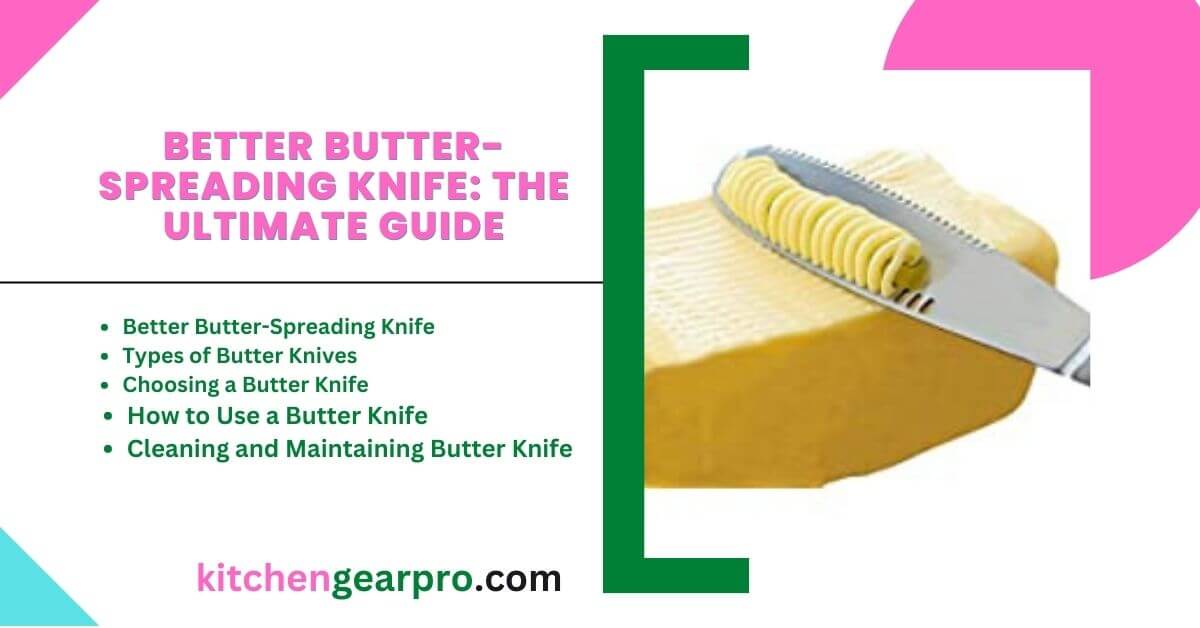Better Butter-Spreading Knife: If you enjoy eating toast, bagels, muffins, or any other bakeries with butter or spreads, you certainly will appreciate the value of an excellent butter-spreading knife. A good butter knife will not only make your kitchen experience more professional but also allow you much easier to spread butter and other spreads on bread without tearing it or leaving clumps of butter on the surface.
Do you wonder how to select the best butter-spreading knife when there are so many options on the market? Then, please read this article to the end, where we will walk you through the various types of butter knives, their features, and how to use them in this article.
Read More: The Four Kitchen Knives You Need for Home Cooking
Table of Contents
Best Butter-Spreading Knife
Although it may seem that Butter knives are not an essential kitchen tool, they could be handy for some recipes and eating habits. These knives are designed for the purpose of spreading butter, soft cheeses, and other spreads. However, not all butter knives are the same, as some of them are better suited to specific tasks, while others are designed to handle a variety of functions.
In this article, we will examine the significant types of butter knives and the parameters you should look for when purchasing this kitchen accessory. We also will mention how to use and maintain your butter knife for maximum performance.
The Different Types of Butter Knives
Typical Butter-Spreading knives are available in three types: spreader knives, serrated knives, and curved knives.
Spreader Knife
The Spreader Knife is the most common type of butter knife available n today’s market; this knife is also may be called a butter spreader or sandwich spreader. They have approximately 3–4 inches long and 1‑inch wide flat blades, which are usually made from stainless steel or sometimes plastic, and have a blunt edge. Their size and blunt edges make them ideal not only for spreading butter but also for such spreadable products as soft cheeses, peanut butter, and other spreads.
Serrated Knife
Another popular type that is used for spreading is Serrated knives; it is also known as bread and butter knives, which have a serrated edge that allows cutting bread and other baked goods to smooth and easy. These knives usually have a longer blade than spreader ones and have, they also have a pointed tip, unlike a typical spreader knife. Serrated knives are very useful in spreading butter because the serrated edge breaks up cold butter much more accessible than other types of knives, so butter or further spread is applied very smoothly.
Curved Knife
The curved knife, which is also known as a butter curler, has a curved blade designed to curl butter into appealing shapes. Its blade is typically made from stainless steel and has a pointed tip. So, Curved knives look very smart and are ideal for serving guests or adding a decorative touch to your dishes.

What to Look for When Choosing a Butter Knife
When choosing a butter knife, there are several factors you should look for.
Material
Butter knives are commonly made of stainless steel, plastic, or a combination of the two materials. Stainless steel knives are tough and long-lasting, whereas plastic knives are light and easy to use.
Handle
The handle of your butter knife should be easy to grip and comfortable to hold. Look for knives with ergonomic handles that fit your hand comfortably.
Blade Length and Width
The length and width of the blade will influence how much butter you can spread at once. Choose a knife with a blade that is wide enough to cover the surface of your bread or bagel but not so wide that spreading becomes difficult.
Dishwasher Safe
Some butter knives can be washed in the dishwasher, while others must be washed by hand. Consider your preferences and lifestyle when selecting an easy-to-clean and maintained butter knife.
How to Use a Butter Knife
After you have found the ideal butter knife, it is time to learn how to use it.
Softening Butter
If your butter is too hard to spread, you must first soften it. Then, allow the butter to come to room temperature for 30–60 minutes, or microwave it on low for 10–15 seconds.
Spreading Butter
Use a 45-degree angle knife and a gentle, sweeping motion to spread butter. Begin in the center and work your way out to the edges of the bread. Excessive pressing can tear the bread or leave clumps of butter behind.
Cutting Bread
When cutting bread with a serrated knife, use a sawing motion and avoid pressing down too hard. This will help keep the bread from tearing or crushing.
Cleaning and Maintaining Your Butter Knife
It is critical to clean and maintain your butter knife properly in order to keep it in good condition.
Hand Washing
If your butter knife cannot be washed in the dishwasher, hand wash it in warm, soapy water and dry it with a soft cloth. Use abrasive cleaners or scrubbers to avoid damaging the blade.
Sharpening
Sharpen your butter knife with a sharpening stone or honing rod if it becomes dull over time. This will help keep the blade sharp and make it easier to use.
Storing
Keep your butter knife in a knife block or drawer to protect the blade and keep it from becoming damaged.
Conclusion
Having a good butter knife in any well-equipped kitchen is a good idea. There is a butter knife to suit your needs, whether you prefer a spreader, serrated, or curved knife. The significant parameters you should look for when selecting the butter knife are the material it is made from, the handle design, blade length and width, and dishwashing friendliness.
Before using your butter knife, you must remember to soften the butter before spreading it; you can use a gentle sweeping motion for this purpose. You also preferably hand wash it and sharpen it regularly to maintain your butter knife properly.
Frequently Asked Questions
Why do I need a Butter knife if I can use a regular knife to spread butter?
Indeed, the regular knife could be easily used to spread butter; however, it is not recommended. Spreading knives are not designed for this purpose and may tear the bread or leave clumps of butter behind.
How often my butter knife needs to be sharpened?
It should be sharpened if your butter knife becomes challenging to use or you notice that it becomes dull. In this case, you should sharpen it with a sharpening stone or a honing rod.
Can I put my butter knife in the dishwasher?
Some butter knives are designed for dishwashing cleaning, while others must be washed by hand. Before putting your knife in the dishwasher, read the product’s user manual.
What’s the best way to store my butter knife?
The best way to store your butters knives is to keep them in a knife block or kitchen drawer so that they will be protected from damage.



